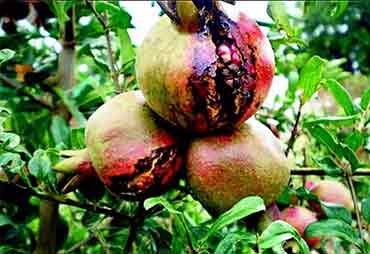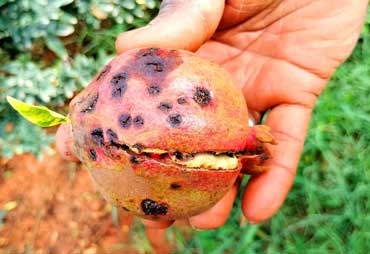


Bacterial Blight
- Water-soaked lesions on leaves and stems, which may turn dark brown or black with time.
- Yellowing and wilting of leaves.
- Dark streaks on the stems and branches.
- Cankers and lesions on fruit, which may ooze a sticky, amber-colored substance.
2. Cultural Practices:Pruning: Prune infected branches and leaves, and destroy them to prevent the spread of the disease. Ensure good air circulation in the pomegranate canopy.
Sanitation: Remove fallen leaves and fruit from the ground, as they can harbor the bacteria and serve as a source of infection.
Avoid overhead irrigation: Use drip or soaker hose irrigation to keep the foliage dry and reduce the spread of the disease.
Plant spacing: Avoid planting pomegranate trees too closely, as overcrowding can promote the spread of the disease.
How Potassium Phosphite Control Bacterial Blight
Potassium phosphite is a phosphorous-containing compound that has been used as a plant disease management tool, particularly against bacterial diseases like bacterial blight. It's important to note that potassium phosphite is often used as a foliar spray or soil drench and is different from potassium phosphate, which is a common nutrient for plant growth. Here's how potassium phosphite can help control bacterial blight:
Systemic Resistance: Potassium phosphite acts by inducing systemic resistance in plants. When applied to pomegranate plants, it triggers the plant's natural defense mechanisms. This enhanced resistance makes the plant more effective in defending against bacterial pathogens like Xanthomonas axonopodis pv. punicae, which causes bacterial blight.
Direct Antimicrobial Effects: Potassium phosphite can directly inhibit the growth of some plant pathogens, including certain bacteria, by disrupting their cell membranes and interfering with their metabolism. This can help reduce the population of bacteria responsible for causing bacterial blight.
Strengthening Plant Cell Walls: Potassium phosphite can reinforce plant cell walls, making it more difficult for bacteria to invade plant tissues. This physical barrier can help prevent or slow the progression of bacterial infections.
Here are steps for using potassium phosphite to control bacterial blight on pomegranate plants:
1.Timing: Apply potassium phosphite preventively during the growing season or when conditions are favorable for disease development. Early applications are more effective at protecting plants.
2.Application: Apply potassium phosphite as a foliar spray, ensuring complete coverage of leaves and stems. It can also be applied as a soil drench for systemic protection. Follow the manufacturer's recommendations for application rates and timing.
3.Repeat Applications: Depending on the severity of the disease pressure and local conditions, you may need to make multiple applications throughout the growing season. This is often done at 2-3 week intervals.
4.Rotate with Other Methods: To reduce the risk of developing resistance in the pathogen population, it's a good practice to rotate the use of potassium phosphite with other management strategies like pruning, sanitation, and copper-based sprays.
5.Monitoring: Regularly monitor your pomegranate plants for signs of bacterial blight. If you detect any new infections, take appropriate measures, which may include additional potassium phosphite applications or other treatments.
It's important to note that potassium phosphite is just one tool in the toolbox for managing bacterial blight. Integrated disease management, which includes cultural practices, sanitation, and the use of multiple control methods, is often the most effective approach to prevent and control this disease. Consulting with a local agricultural extension office or an expert in plant disease management can help you develop a comprehensive strategy tailored to your specific conditions.






